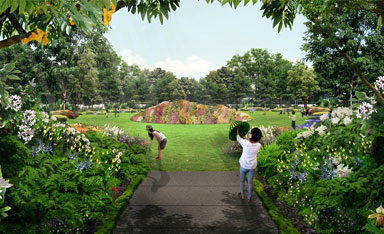Among the curiosities in this collection are trees with bark that peel off like sheets of paper, and trees with black bark. Visitors here can find out why the Cannonball Tree, Monkey Pot Tree and African Sausage tree have such odd common names, as they enter this fascinating world of unusual trees and fruits, and learn more about them.
Plant collections
Trees in the Nature Play area include some with interesting types of bark.
The Paper Bark Tree (Melaleuca cajuputi) has thick, spongy bark that is whitish- to greyish-brown, and look like sheets of paper when it peels off the trunk. This tree is also known as Kayu Puteh, which means ‘white wood’ in Malay.
The Leopard Tree (Libidibia ferrea)[1] gets its name from its smooth, light grey to ivory bark, which is mottled with brown or dark grey patches. The bark peels off in batches with age.
Diospyros rhodocalyx belongs to the Ebenaceae family, which comprises trees with black bark that produce ebony, a type of dense, black wood.
Rainbow Eucalyptus (Eucalyptus deglupta) is characterised by its multi-coloured bark featuring hues of green, orange and maroon.
The Cannonball Tree (Coroupita guainensis) is known for its large, round and heavy fruits attached to its trunk. These large fruits fall to the ground with a loud thud.
The Monkey Pot Tree (Lecythis pisonis) produces large, woody capsules, each with an opening that resembles a lid which makes it look like a pot. Monkeys in South America are known to put their hands into the “pot” to get to the rich seeds, hence the tree’s common name, Monkey Pot.
The African Sausage Tree (Kigelia africana) produces sausage-shaped fruits. Fresh fruit from the tree is poisonous to humans – it has to be processed before it can be consumed.
The Calabash tree (Crescentia cujete) produces green, oval, gourd-like fruits. Ripened fruits turn brown and can be used to make household utensils or musical instruments.
[1] Source: Wild Singapore (Melaluca cajuputi), NParks Flora Fauna Web (Libidibia ferrea, Eucalyptus deglupta), LaFrankie, JR. James V, Trees of Tropical Asia, An illustrated guide to diversity (Diospyros).



